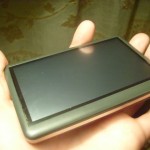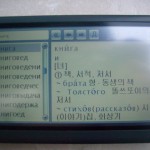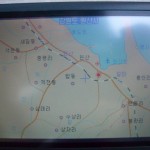UPDATE: Martyn Williams writes in PC World (11/5/2010):
A new PDA (personal digital assistant) has hit stores in North Korea, according to a student who writes a blog from the secretive state.
The device, which doesn’t appear to carry any branding, has a color touchscreen display that occupies its entire front, according to photos published on the “Pyongyang Show and Tell” blog. The Russian-language blog is maintained by a Russian student who is studying in the country.
Installed software includes a Korean dictionary and translation dictionaries pairing Korean to and from Russian, English, Chinese and German, the blog report said. There are several basic utility programs and an electronic map of the country although the PDA does not feature GPS (global positioning system).
There is also no wireless networking so data transfer has to take place via a USB connection to a Windows or Linux computer. Data can also be transferred via MicroSD card, which is the same as used in domestic cell phones.
“Comparing it to modern things like, let’s say, the iPad, it’s nothing,” the blog’s author, who didn’t wish his name to be used, told IDG News Service via email. “It’s still good as a dictionary, except I don’t see any other advantages.”
It’s not the first PDA in North Korea.
In 2003 the country’s media said “Hana 21,” a PDA developed by the Samilpo Information Center, had been put on sale. The device included English-Korean and Korean-English dictionaries as its main function and also had several games and a basic word processor. Input was by pen and touchscreen.
According to published images of the Hana 21, the two devices are different.
At the time the Hana 21 was said to cost around 200 euros (US$182 at the exchange rate of the time).
The new PDA that hit stores recently costs around US$140.
“It’s still hard to buy for a Korean, but there are many people who keep their money for years and can afford it,” the student said via email.
PDAs have long been out of fashion in many countries after their features and functions were duplicated by smartphones. North Korea has a 3G cellular network, but most cell phones have only basic features.
ORIGINAL POST: Show and Tell Pyongyang introduced the world to the DPRK’s version of Linux: Red Star. Now he has introduced us to the DPRK’s new Personal Digital Assistant (PDA).
Here are pictures from the Russian web page:
According to the Russian-language web page (via Google Translate):
A few weeks ago in North Korea has started selling the first PDA. In all the computer shops you can see the advertising of the new items. [I] offer a small review of this device.
On sale are a few options. The difference between them – is the amount of internal memory and a built-in slot for the stylus. The most feature-rich [costs] $ 140 and has 8 gigs of internal memory and a slot for the stylus, so you do not accidentally lose it.
In addition, there is a slot for MicroSD memory cards – the same as in the local mobile phones.
The main function of which is worth noting (and more generally for which there is a fly sabzh), an electronic dictionary Samhyn (삼흥) with the Russian language. It is no secret that South Korea produced electronic translators, but, according to eyewitnesses, the Russian language is absent in them as fact. And in this case, Russian-Korean and Korean-Russian dictionaries most voluminous in the number of vocabulary words. Besides, there are English, Chinese and German. Also has a large Korean Wiki Grand Korean Dictionary.
So for me personally, the main value of the PDA – is an electronic dictionary, which can carry with them always and everywhere. And the rest is not so important.
So what else is there? There is a map of Korea’s system of teaching foreign languages (English, Chinese). By the way, about a month ago there was an opportunity to put maps on your mobile phone. Application free of charge and requires activation. Put it on a large computer center of the city. []
Device has access to TV, headphones and a USB-slot. Possible to connect devices to both Windows, and Linux (in this case, Red Star)
On the whole – everything is simple and works quite well. At the moment, the firmware needs some work, not all features fully implemented, but the Korean comrades promise to update and refine.
If anyone else has more information, please let me know.



